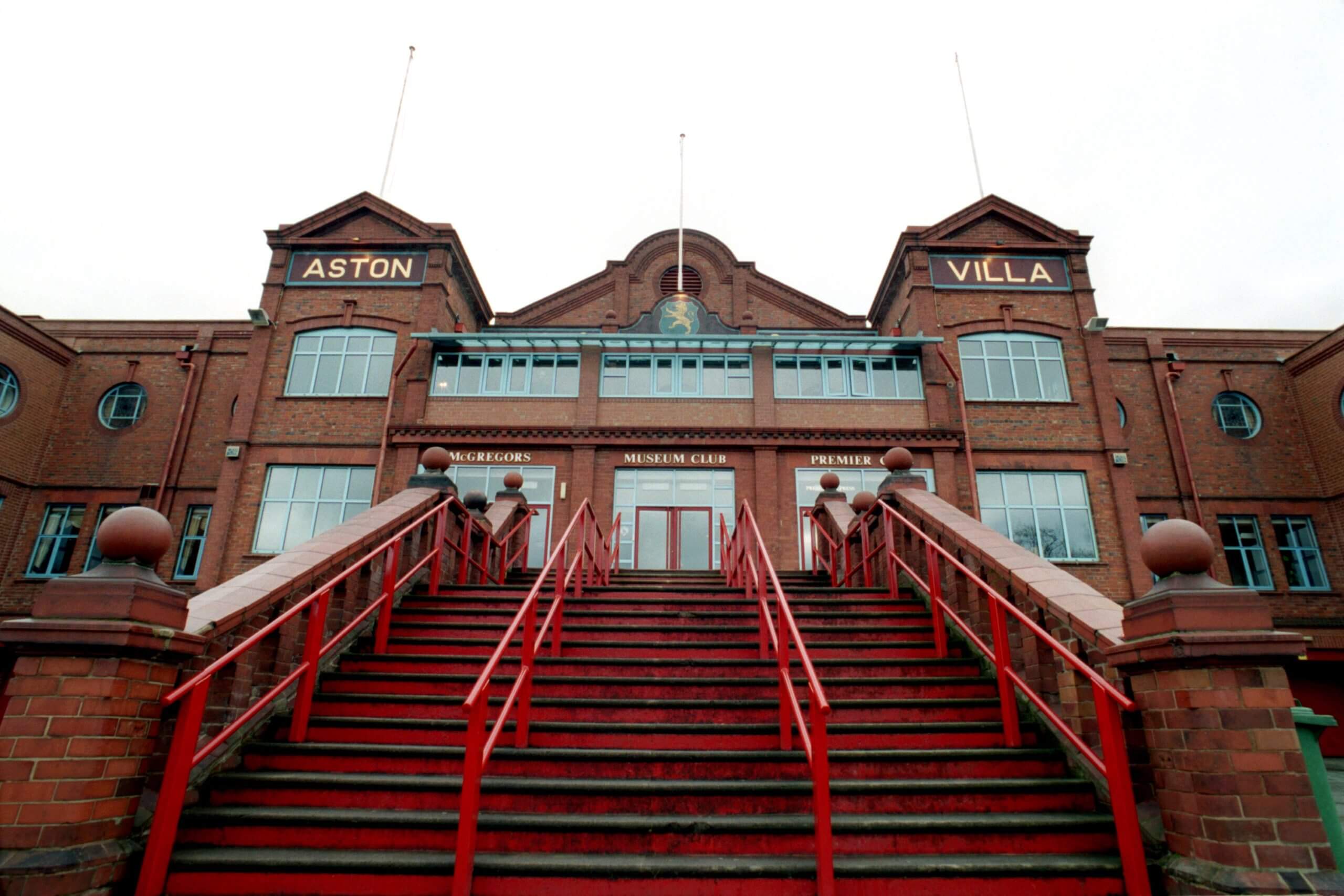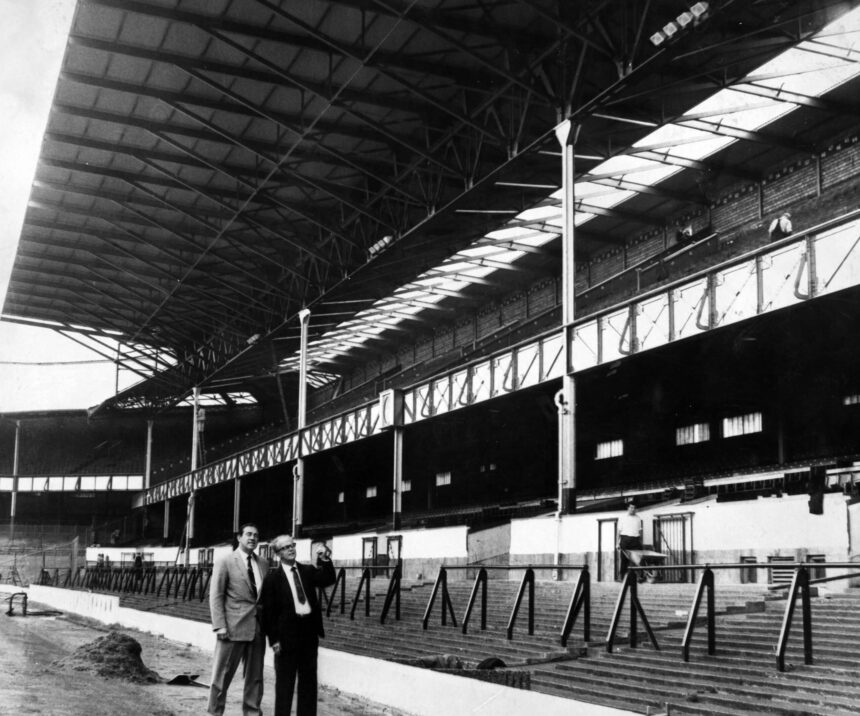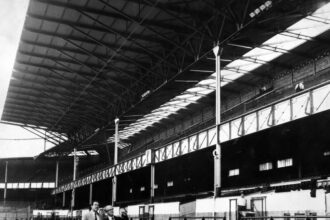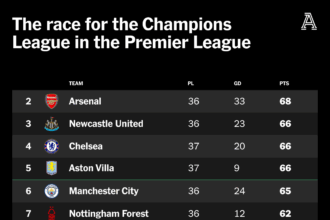For 99 years, the criss-cross balcony motif that runs along the Bullens Road Stand has been the symbol of Goodison Park’s enduring charm.
On Sunday, those season-ticket holders in the front row of the stand’s top tier will have one last opportunity to drape their flags and bang on the steel before Everton (the men’s team anyway) say goodbye.
Advertisement
The balcony was not always in the club’s blue and white colour scheme, as it is today. Originally, it was painted matt green because this was a functional aspect of the design by its Glaswegian architect, Archibald Leitch, in 1926, rather than a deliberate aesthetic extra, even though it has become fashionable to use the reversed saltire as piping on the collar of Everton’s home kits.
The pattern was obscured from view by advertisements for many years, which is fitting considering how Leitch, a colossus in the fabric of British football in the 20th century, has been forgotten by the wider community.
He is the godfather of British football stadiums, the man whose drawings and engineering brought to life dozens of stadiums that stood for almost a century.
Between 1899 and 1938, he was the brains behind more than 45 stands at grounds in England and Scotland. Middlesbrough’s Ayresome Park became the first purpose-built football stadium in 1903, and when England won the 1966 World Cup on home soil, six of the eight stadiums to stage matches during the tournament were either fully Leitch designs or featured his stands.
John Moores, the Everton chairman, right, and manager Harry Catterick inspect the new roof on Goodison’s Bullens Road Stand in 1963 (Liverpool Echo/Mirrorpix/Getty Images)
Some were complete builds and others were redevelopments but the list of Leitch clients included Liverpool, Manchester United, Chelsea, Arsenal, Tottenham Hotspur, Aston Villa, Crystal Palace, Blackburn Rovers, Fulham, both Sheffield Wednesday and neighbours United, Bradford City, Sunderland, Leeds United, Rangers, Heart of Midlothian and Dundee.
He set the template for what was possible in an experimental period where football was evolving into a thriving commercial entity.
But after Leitch died in 1939, his contribution to British football was barely remembered. His name was invisible for decades, until the exhaustive research of stadiums expert Simon Inglis brought his body of work to life in his 2007 book Engineering Archie.
It is a rich resource that the architect of Everton’s new home at Bramley-Moore Dock, Dan Meis, mined as he considered how he could respectfully carry on the baton.
Meis has designed many stadiums and arenas across the world in the past 30 years, including the Staples Centre in Los Angeles and Qatar’s Sports City Stadium for the 2022 World Cup. Roma’s new 52,000-seater ground, which they will move into in 2028, is another, but the Everton commission has been a unique experience because of how involved the fans have been and the weighty task of following in Leitch’s footsteps.

There are subtle nods to Leitch at Everton’s new stadium (Christopher Furlong/Getty Images)
“It is incredible when you think about how long Goodison and Leitch’s work has lasted,” Meis tells The Athletic. “There is nothing like it. That is testament to the innovation, energy and intimacy he created. In the United States, we have one-billion-dollar stadiums that sometimes get replaced within 25 years.
Advertisement
“One thing that was clear when I first met Everton was that they are not like other clubs. The discussion quickly became about the people, the place, the history of the club and the city. It was clear that it was less about architecture and more about how do you capture the magic of Goodison because, for all the challenges of its age, it is one of the great footballing experiences.
“The fans were very sophisticated about their brand and the architecture of Archie Leitch. I was getting messages telling me what it should be like. It felt like I was collaborating with the entire fanbase — it was kind of intimidating!”
Finding a way of bottling Goodison’s soul was the gist of those messages. The American contemplated taking literal sections of Leitch’s balcony and integrating them into his design, but eventually he has sought to memorialise instead.
“In some ways, being an American gave me an advantage because I didn’t take anything for granted,” Meis says. “Leitch is a huge part of the history of English football, and there was a lot of engineering innovation in the way they added second tiers to stands and the expression of the truss (criss-cross steelwork) became an iconic symbol of the club.
“But once we started work, I really dove in deep and learnt a lot about him and a lot of historic grounds.
“It is very subtle but in the actual brickwork (of the new stadium) we have a pattern that references the Archie Leitch truss in different coloured bricks. The plazas have utilised the truss-work pattern, (and) the railings and concrete benches. It is all very subtle, rather than trying to be too kitschy, but they are definitely nods to the Archie Leitch history.”
Sunderland rehoused a section of the red and white latticework from Roker Park, their old home, in the car park at the Stadium of Light when they moved there in 1997, while Tottenham migrated sections of the White Hart Lane criss-cross pattern to their new stadium in 2019 and placed them above the bar in its hospitality suites.

Sunderland’s tribute to Leitch in the car park outside the Stadium of Light (Phil Buckingham/The Athletic)
The Scot built 17 stands with the iconic pattern but only three remain: the Bullens Road at Goodison, the Bill Struth Main Stand at Ibrox, home of Glasgow giants Rangers, and the South Stand at Portsmouth’s Fratton Park.
A Leitch stand has been an endangered species for decades, and there are now fewer than 10 left, which is why Everton’s men’s team moving out of Goodison on Sunday will be such an emotional day for many.
Advertisement
“It will be a poignant day, but the news that the women’s team will be taking over the stadium is excellent,” Leitch’s grandson David Easton tells The Athletic. “It means his legacy will remain, and hopefully it can encourage more people to get behind the team. Our family are delighted.”
Easton, 63, and his children are Tottenham supporters based in Kent, in the south-east of England. His dad was not a football fan and Easton was only nine when he died, but his father was able to share anecdotes with them on how fanatical a Rangers supporter Leitch was.
It was only through Inglis’ book, however, that Easton truly learned about the extent of his grandfather’s imprint.
“I’m still surprised his name isn’t as well-known in football,” he says. “It is only as more and more teams leave or knock down the stands that his name crops up, but he created so many of these ‘cathedrals’. That’s what Goodison is. It’s a cathedral that people have come to once a fortnight for 100 years and love it like no other place. We are Spurs fans and my son got in touch with the club this season to inform them of our connection and we were blown away by the noise. Goodison is that little more intense.
“Not many structures last for 100 years, especially when they were built in that era. It is a surprise that they didn’t move earlier when you look at the old pictures of the terracing and how packed in everyone was.
“It is an amazing privilege to be part of his work and, for as long as me and my sons are alive, we will keep telling the story.”
Meis has been engaged to build a stadium that will allow Everton to compete commercially.
Although Goodison has played host to more top-flight English games than any other, the capacity was reduced to just over 40,000 in the 1990s.
More than a century ago, Leitch’s expertise was requested under similar circumstances. Henry Hartley’s Goodison Park design had helped make Everton one of the pre-eminent clubs but the facelift Leitch provided for Anfield in 1906 meant their city rivals were threatening to overtake them.
Advertisement
In 1909, Leitch was hired to build a new Main Stand. In 1926, he added the Bullens Road Stand, and in 1938, when he was 73, designed the Gwladys Street End.
Leitch had built his first double-decker stand (terracing at ground level, seats in the tier above) for Bradford Park Avenue in 1907, but he learned from Hartley’s work on the Park End at Goodison, which saw the upper tier raised higher so that the terracing underneath could stretch all the way back.
He applied the same method, but on a bigger scale at Goodison. Just as the sheer height of his stand at Anfield saw it christened the Spion Kop — named after a prominent hill in South Africa — the 14,500-capacity Main Stand at Everton was nicknamed ‘Mauretania’, after the world’s largest ship, which had recently docked in the city’s harbour.

The Leitch-designed Main Stand under construction at Selhurst Park, now home of Crystal Palace, in 1924 (Osbourne/Topical Press Agency/Hulton Archive/Getty Images)
By 1938, Leitch had made Goodison the first stadium to have seats and terracing on all four sides, all of them double-decker, which was also groundbreaking.
Leitch was actually a factory designer by trade, which is why many of his early works were functional. He knew how to build in a cost-effective and efficient way, which garnered him a level of respect in the game.
He was not the first to build a stand, a pavilion or a grandstand, but he did it on a scale and at such a prolific rate that he wrote many of the rules which stood for most of the 20th century: the dimensions of terracing, the sight lines and the patented crush barriers he installed in unbroken lines — advice that was mostly ignored by clubs until the Hillsborough disaster in 1989.
That loss of 97 Liverpool fans led to the Taylor Report, which recommended that all stadiums be converted to all-seater models. It meant the sudden revamping or erasure of the vast majority of Leitch’s creations.
Tragedy is what bookended his era of architectural dominance.
Advertisement
Indeed, his career in football could have been over before it really began.
Having successfully lobbied to have the 1902 edition of the annual Scotland-England international staged at Ibrox, Leitch arrived at the home of his beloved Rangers three hours before kick-off to observe what should have been a crowning moment in his life. He had helped dream up an 80,000-capacity stadium, the world’s largest, before his 37th birthday.
Instead, 40 minutes into the game, after various issues with crowd control and crush barriers, despite the recorded attendance being 12,000 under the official limit, he witnessed any architect’s worst nightmare unfold.
Seventeen wooden joists in the south-west corner’s terracing collapsed, sending those standing in the affected area through the floor, with some mangled in the steel and others plunging all the way to the ground.
In total, 26 people died, 516 sustained injuries and 587 would receive compensation. The cost of restoring the stand almost bankrupted Rangers but an upset Leitch stated he was “surely the most unhappy eyewitness of all”.
There was a court trial. Rather than Leitch being in the dock, it was the contractor Alexander McDougall, accused of culpable homicide. Leitch apportioned blame on the basis that McDougall had ignored stipulations in the contract by using shorter length joists and substituting red pine for weaker yellow pine.

The Trinity Road Stand at Villa Park was a Leitch masterpiece – it was demolished in 2000 (John Walton/EMPICS via Getty Images)
McDougall was found not guilty, as several leading architects questioned the calculations in Leitch’s design. Leitch risked being a pariah but avoided potential stigma as Rangers retained his services for the rebuild, and commissions south of the border then followed.
Rather than allow the tragedy to define his life, Leitch used the lessons as motivation to ensure it never happened again. He helped progress the standards and safety of football immeasurably.
“My son studies drama and writes musicals,” says Easton. “He is thinking of writing one called The Ibrox Man, about how he recovered from the disaster because, although he had done some work, most of it came afterwards. The way he responded is the real story.”
Advertisement
Fulham’s Craven Cottage pavilion, the Trinity Road Stand at Villa Park, completed in 1924, and the South Stand at Ibrox, in 1928, were widely credited as his best work.
Villa demolished that stand in 2000 and at Manchester United’s Old Trafford the only remaining part of the 1910 design is the ‘Munich tunnel’, which was used as the players’ entrance until the 1990s.
Easton and his son Sam were invited as special guests to the opening of the Ibrox museum in 2023, where they were given a special tour of the stadium and shown the replica model Leitch used to pitch his ideas to the Rangers board, which was only rediscovered in recent years.
Leitch was engaged by Rangers on two separate occasions but the red-brick facade on the Main Stand was the pinnacle. It remains in great condition and is listed, albeit there were changes in the 1990s.

The Main Stand at Ibrox (Craig Williamson/SNS Group via Getty Images)
“It was only when we went there in person that we realised how incredible it is,” says Easton. “It is old-fashioned but timeless. The reception, with the marble staircases, is wonderful and it is fitting that, being such a mad Rangers fan, he created something so special just minutes from where he lived.
“When we went out onto the grass and looked up, you could really appreciate how impressive the scale is. A man found out we were his family and was in awe, saying, ‘If it wasn’t for Archie, we might not be here’ and it made me think about how significant a role he played at so many clubs. He was a pioneer.”
Meis hopes his design for Everton can have the same longevity after he prioritised the acoustics to ensure it replicates Goodison. “Not too many fans have been able to get inside Bramley-Moore yet but they will notice instantly that we’ve got fans close to the pitch,” he says.
“There’s such a commercial emphasis on adding boxes but a lot of those things that drive the stadium to become larger push a lot of the seating away from the pitch. We tried to stay as close as we could, inside regulations. The upper deck (South Stand) is very steep and feels like you are on top of the pitch.
“Of all the new grounds in the last 10 to 15 years, that is what will stand out.”
(Top photo: Robbie Jay Barratt – AMA/Getty Images)









